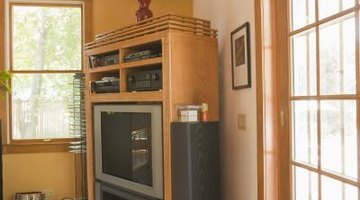Cutting Holes in the Back of an Audio Cabinet
Purchasing a cabinet to house your audio components, such as CD player, stereo receiver and MP3 player docking station, will help keep these elements of your home entertainment system together. Some cabinets contain holes or openings in the thin wood behind them to allow cables to pass through, while some don't. If your cabinet doesn't have these holes, you can cut them as needed instead of running the components' cables out through the front of the cabinet.

Step 1
Move the cabinet, once loaded, out from the wall as much as you can. Moving it will allow you to access the rear of the cabinet easily to see exactly where you will need to cut the holes. Unless the cabinet is extremely small, recruit an assistant to help you move it.
Step 2
Use a pencil to mark on the rear of the cabinet the approximate locations of the audio components on each shelf of the unit. You can achieve this by eye or by using a tape measure. If using a tape measure, measure the height off the ground to the first component and then the distance from the edge of the cabinet to the device's plug.
Step 3
Move all the audio components off the shelf to ensure they're safe from the cutting process. If the shelves slide outward, this movement might be enough to keep the components safe.
Step 4
Drill a hole with a drill and a large drill bit if you wish to use a drill for this process to keep the holes small. Remember that each hole has to be big enough to allow not only the cord to pass, but also the plug. If you don't have a drill bit large enough for this task, you can use a jigsaw.
Step 5
Cut a suitably sized hole in each designated area with a jigsaw. Cut each hole large enough for the plugs to pass through with ease.
Warnings
- Make sure all the audio components are out of the way when you begin drilling or cutting to avoid cutting through a cable.
Writer Bio
Toronto-based journalist William McCoy has been writing since 1997, specializing in topics such as sports, nutrition and health. He serves as the Studio's sports and recreation section expert. McCoy is a journalism graduate of Ryerson University.
Photo Credits
- Thinkstock Images/Comstock/Getty Images
More Articles



